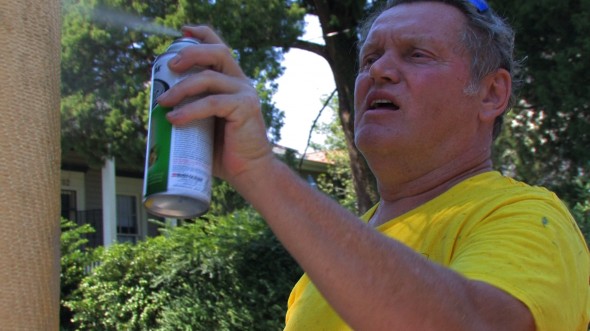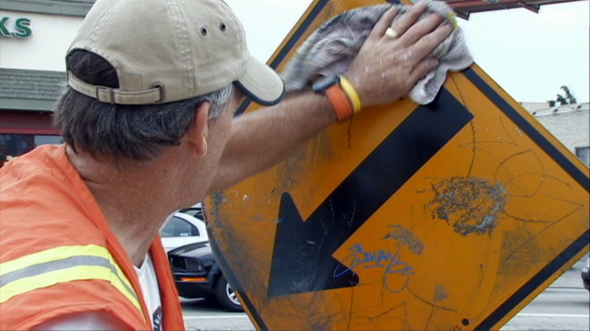REVIEW: 'Vigilante Vigilante'
Graffiti is an issue that splits urban societies down the middle. You have the artists who argue it’s a noble pursuit, and the community activists who want it wiped out. The war of words about graffiti is unlikely to end, but a new documentary, Vigilante Vigilante: The Battle for Expression, decided to follow those who take graffiti “abatement” into their own hands.
Vigilante Vigilante is a film populated by a cast of colourful real-life characters who have made erasing graffiti their lifelong quest. Director Max Good and his crew follow these crusaders and others on both sides of the graffiti argument, crafting a doc that digs into the nature of art and the many interpretations of free expression.
The film alternates between three specific anti-graffiti activists: Berkley, California’s Jim Sharp (known as the Silver Buffer), Los Angeles’ Joe Connelly (the Graffiti Guerrilla) and New Orleans’ Frank Radtke (the Gray Ghost).
Each one has adopted an aggressive (in Radtke’s case, allegedly violent) stance towards graffiti. They go about their neighbourhoods wiping out instances of graffiti with silver and grey paint, doing what they believe others are unwilling to do.
These men are not portrayed in a very positive light. The film was shot by a group of graffiti “writers”, or taggers, who state several times in the film that they want the anti-graffiti “buffers” to stop erasing their work.
Buffer Joe Connelly is perhaps the most sympathetic to the graffiti artists’ efforts, but all three buffers feel that graffiti is sign of the degradation of society, behaviour that will lead to robbery, violence and even murder.
It doesn’t really matter that this film represents the anti-graffiti community as a bunch of crazies. Documentaries with a certain slant can be just as revealing as objective works. And there’s no denying what the filmmakers present in their interviews and walkabouts with the buffers. Jim Sharp is determined and argumentative, Connelly is loud and charismatic, and Radtke is vitriolic and possibly delusional.
It’s clear that all three are just as much in the wrong as the original “vandals”, because they deface the defaced property, leaving behind swaths of paint which they hope call attention to the crime. The artists feel this is hypocritical and misguided, but the buffers persist because like a comic-book vigilante, to stop fighting is to admit defeat.
The buffers and the authority figures get plenty of time to state their case. It’s interesting that when they talk about street art, the anti-graffiti movement falls back on the same argument connecting it to crime or claiming that it’s all illegal.
By contrast, when the supporters of graffiti speak, they all seem more intelligent, more balanced and more layered than the “good guys”. Their arguments are well-reasoned examinations of human society, making Frank Radtke and Jim Sharp look like unimaginative old men trying to kill good art.
In terms of its construction, Vigilante Vigilante is a complex blend of animated sequences, archival news footage, stakeout shaky-cam and high-definition sit-down interviews. The multiple flavours of filmmaking suit the graffiti theme. While the handheld footage speaks to the underground nature of the form, the well-framed interviews “legitimize” the film as a proper documentary.
The animations are used for interview intros and background information. Like the varying live action styles, it helps pack the film with even more visuals than the graffiti can provide. The animations also incorporate a sense of humour, sometimes exaggerating what is said in the accompanying voice-over track to comic effect.
Vigilante Vigilante is actually a very funny movie. Interviews with buffers and artists alike overflow with colourful turns of phrase. Entertaining arguments occur between the filmmakers and the buffers they encounter. The filmmakers haven't lost sight of the fact that this a documentary about art, rather than a hard-hitting scandal. The film strikes a good balance between fun and serious discussion.
Just like its balanced tone, the film is equal parts professional and student-made – it's competently produced and still retains a youthful honesty. The editing by Julien de Benedictis keeps a steady pace, juggling the various visual styles, despite occasionally uneven cuts between scenes.
By the end of the film, there’s a sense that the filmmakers and Jim Sharp have almost become friends. They tolerate each other’s views and respect each other’s determination to either put up graffiti or to take it down.
There’s a great scene at the end where the filmmakers follow Jim Sharp on his morning buffing rounds, spray-painting his abatement work with a brighter colour to call attention to his “vandalism”. Sharp can only look on in bemusement as the filmmakers highlight just how cyclical the battle between artists and buffers is.
I found myself siding with the graffiti artists in this one, only because I once shot my own documentary (short form) about a graffiti artist. I think the key virtue of Vigilante Vigilante is that it doesn't ignore the other side of the argument, even though the crew has a declared bias. It’s an added bonus that Max Good and his team have crafted an entertaining and visually layered film to convey their message.
The documentary could have been a pile of handheld camera shots of disillusioned old men painting over street art. Vigilante Vigilante is much more, and for that, it gets three and a half stars out of four.
Have you seen Vigilante Vigilante: The Battle for Expression? Do you feel that the filmmakers’ lack of objectivity ruined the film? Did you like the visual style of the doc? Where are you on the “graffiti as art” debate? Let me know what you think in the comments section down below. You can also browse through my recent movie reviews by following these links:
In Time | The Three Musketeers | The Ides of March | Moneyball
-



